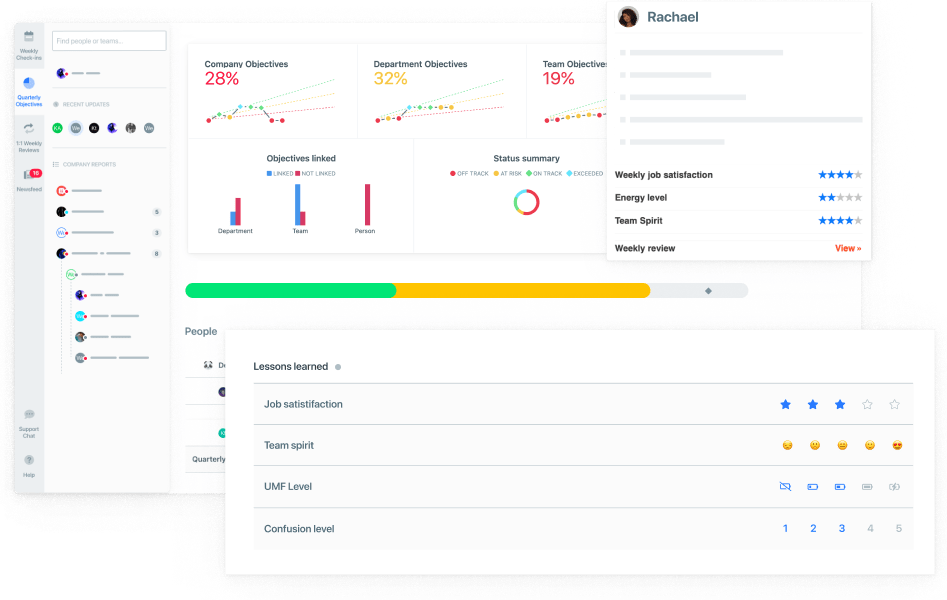Finding Success in SaaS Using OKRs
For the past few years, Webapper has built its business around some key performance indicators. And with minimal disruption, we’ve silently pivoted and improved our business. We were able to make transformational progress by setting goals and making our entire team aware of the plan. In fact, our team is all involved in setting up our Objectives & Key Results (OKRs). We start with a management view (the big goals), discuss and adjust them with the team, and then map individual OKRs to the company’s. With that foundation, we wanted to share our method, which we think will help our community. Here’s our guide to finding success in SaaS using OKRs.
Define Success
Your organization has a culture. Perhaps it’s unwritten, or perhaps you’ve created a Culture Book that you share with new team members. But hopefully you’ve create a framework that defines your vision of success. At Webapper, we’ve embraced the “Mission Vision Values” approach.
Mission
Your mission statement defines your organization’s purpose. Your mission statement describes who the company is and what the company does. When you design (or redesign yours), focus on what is most important to your organization. Be brief, informative, and simple.
Vision
Your vision statement describes the future of your organization. Describe what the business hopes to achieve over the long term. Your vision statement should be a guide for choosing course of action. Be concise, realistic, and aspirational.
Values
Your values statement highlights your core principles. The goal is to guide your team’s decisions and behaviors Be simple, actionable, and memorable.
Metrics
In addition to having the “subjective” foundation for your success, it’s also valuable to have the analytical. We write about metrics in nearly everything we talk about. What gets measured gets done… Revenue is an obvious scorecard for your business, but you may also want to monitor other health indicators in areas like growth rate, customer feedback, and employee morale.
Objectives & Key Results Defined
OKRs are not new. The concept was introduced at Intel in the 70s, as documented in “Measure What Matters” by John Doerr. In addition to how Intel used them, the book walks through how diverse organizations like Google and music artists U2 and philanthropist Bill Gates has embraced and benefited from OKRs.
As described on What Matters (Doerr’s website), “OKRs stand for ‘Objectives and Key Results. It is a collaborative goal-setting methodology used by teams and individuals to set challenging, ambitious goals with measurable results. OKRs are how you track progress, create alignment, and encourage engagement around measurable goals.”
Simply stated, the OKR framework can help any organization or individual achieve more.
Planning SaaS OKRs
OKRs don’t happen in a vacuum. They’re planned in advance, monitored in the middle, and reviewed at the end. Most OKR systems are driven by quarterly goals that roll up to annual ones. At Webapper, we follow calendar quarters — we just set our objectives for Q3 (it’s July). Planning for new quarters and review for prior quarters takes some time, so we meet to discuss OKRs more frequently at the turn of a quarter.
Our management team guides the process, but it’s not entirely top-down. We set some strategic goals (e.g., we launched our own SaaS product, which had its own OKRs), and the team fleshes those goals out and helps define the OKRs we attach. It’s highly collaborative and motivating. Each team member has input to the company OKRs and then they write their own to align to those for the quarter. We’re all rowing the boat in the same direction. Team alignment is absolutely essential.
Examples of SaaS OKRs
Your OKRs will be unique to your business, but we’ll share some examples and explain how we use different tools within our goals.
Objective: Deliver a Better Customer Experience
Key Results:
-
- Capture 100 NPS scores.
- Collect 10 new testimonials.
- Reduce onboarding time to 1 day.
- Confirm customer goals during onboarding.
- Respond to 100% of support tickets within 1 hour.
- Resolve 90% of all support tickets.
We’ve had this OKR in real life, although we’ve fabricated the details for the example. As we’ve discussed regarding retention, metrics matter. Your help desk or customer success team should be accountable for retention — if they don’t deliver, customers will churn out quickly. Our example offers a way to measure (Net Promoter Score) to see how we’re doing. We also factor in speed of our service delivery to measure how we’re doing (hypothesis: if a customer doesn’t get a pronpt reply, they’ll churn out). And then we’re committing to a higher quality, keeping our “TBD” ticket list at under 10% (e.g., bugs that take time…). Note that most goals are immediately measurable (counts/percentage), which is a good goal for your goals!
Objective: Add 100 New Subscribers
Key Results:
-
- Develop 2 new lead magnets.
- Run 9 growth experiments.
- Deliver 500 new market qualified leads.
This OKR example is about marketing and growth. We’re focused on lead acquisition, which includes some specific tasks we know will be needed. Note, everything has a measurable metric.
Objective: Keep Churn Rate Under 5%
Key Results:
-
- Send monthly subscriber newsletter.
- Profile a customer in each monthly subscriber newsletter (success story).
- Check in with every Gold customer at least once per quarter.
- Check in with every Platinum customer once per month.
- Develop 3 new winback offers.
- Look into preventive support.
Here’s another look at handling customer experience — with specific actions to keep churn down. Each is manageable and measurable. One (the last one) is forward-looking — to start research for a process that will probably start in the next quarter.
These OKRs all represent things at a company or department level. What would an individual’s OKR look like? Here’s one for the first Customer Experience…
Objective: Deliver a Better Customer Experience
Key Results:
-
- Design an email template to send to all customers once per quarter for NPS scoring.
- Design an email template to send to all customers who respond to the NPS responders.
- Map current customer journey from post-sale to contract renewal.
- Design onboarding drip campaign to shorten onboarding process of customer journey.
- Include an onboarding step that confirms customer goals during onboarding. Implement ASAP.
- Respond to all my support tickets within 1 hour.
- Resolve 90% of all my support tickets.
You see how the company goals can expand to more specific tasks for a team member. That is, the staffer proposes how they can contribute to that specific OKR.

OKR Tools
We started tracking OKRs in a homemade spreadsheet, and we still use text documents and spreadsheets to set up our OKRs. But we use a wonderful online OKR tool called WeekDone for measuring what matters. You may find another option you like better. Competitive options mentioned are ClickUp, 15Five, Lattice, Betterwork, Perdoo, and Workboard. We like the way WeekDone fits our approach, and it’s reasonably priced.
Don’t Set It & Forget It!
Reviewing OKRs throughout the quarter is critical. Some people update their progress all the time, while others pop in updates when reminded — we look at the overall company status on WeekDone each week. These check-ins can be humbling when “life happens” and goals get derailed. The reviews are really about keeping up spirits, though, so even if goals are falling short, it’s not demotivating. Other team members may offer help, or the team can look for ways to adjust to reach the goal. Like building software, if you wait until the last minute, you’ll probably miss the deadline, so slow & steady is the best approach.
Finding Success in SaaS Using OKRs
We live on OKRs; so does Google. OKRs fit any size organization, from solopreneurs to multinationals. And they help you succeed by giving you a quantitative way to keep score on the things you think are most aligned to your mission, vision, and values at the present stage of your business. Yes, challenges will intervene, but no, that’s not an excuse to stop working toward the goal. For example, we didn’t see the pandemic coming to disrupt our business. And yet we continued our pivot and came out stronger on the other side. We stuck to our process. We think that’s the recipe for finding success in SaaS: be nimble and measured, but focused and tenacious. If you haven’t already, give OKRs a look!


Leave A Comment